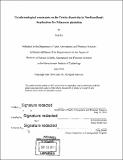Geochronological constraints on the Trinity diamictite in Newfoundland : Implications for Ediacaran glaciation
Author(s)
Pu, Judy (Judy P.)
DownloadFull printable version (2.380Mb)
Other Contributors
Massachusetts Institute of Technology. Department of Earth, Atmospheric, and Planetary Sciences.
Advisor
Kristin Bergmann.
Terms of use
Metadata
Show full item recordAbstract
The Avalon terrane in Newfoundland includes the Ediacaran Gaskiers Formation, which has been associated with a Snowball glaciation event. The complicated regional stratigraphy and lack of precise geochronological constraints has made it difficult to determine the spatial and temporal extent of the Gaskiers glaciation. Recent recognition of a diamictite facies on the nearby Bonavista Peninsula correlative with the Gaskiers diamictite has allowed for new, high-precision geochronological constraints on the Gaskiers glaciation and constrains the duration of the event to less than 390 ±320 kyr. The Snowball Earth hypothesis requires that glaciation continued for several millions of years so that CO2 could build up to high enough levels in the atmosphere for catastrophic deglaciation; the short duration of the Gaskiers event makes it unlikely to have been a Snowball event. Further geochronological studies are needed to determine whether the Gaskiers glaciation was a discrete event or if it was a glacial maximum in a longer Ediacaran ice age.
Description
Thesis: S.B., Massachusetts Institute of Technology, Department of Earth, Atmospheric, and Planetary Sciences, 2016. Cataloged from PDF version of thesis. Includes bibliographical references (pages 21-26).
Date issued
2016Department
Massachusetts Institute of Technology. Department of Earth, Atmospheric, and Planetary SciencesPublisher
Massachusetts Institute of Technology
Keywords
Earth, Atmospheric, and Planetary Sciences.